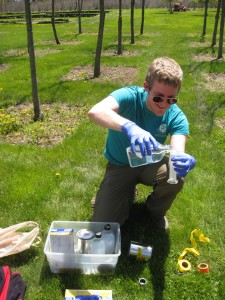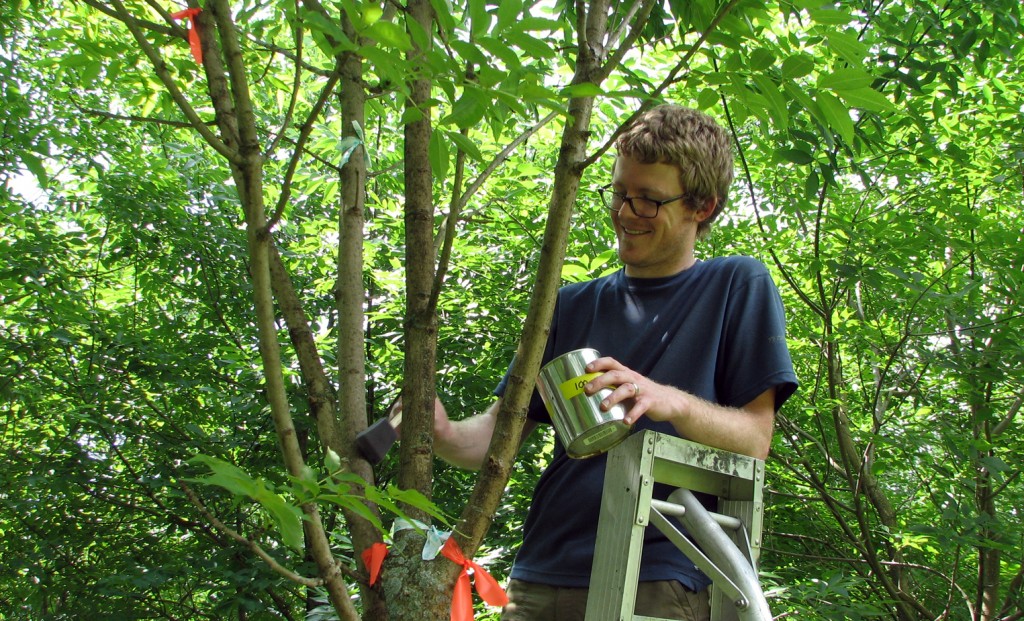When David Showalter decided to focus on plant pathology, he didn’t anticipate he’d ever mount an online donation campaign to support his research. But Showalter, a 2009 biochemistry graduate of Eastern Mennonite University, is writing press releases, explaining collected data, and producing video segments in efforts to capture the attention of potential donors to his research project hosted by a scientific crowdfunding site called Experiment.com.
The PhD student, in his fourth year of studies, is involved with one of the first projects at The Ohio State University to take advantage of the new platform matching scientists with donors.
To directly connect with the public, many scientists have turned to the social media, but using it effectively is a challenge. Showalter says he is learning as he goes, providing research updates and interesting scientific links on Twitter.
But in late October, Showalter had a little fun: “Need a nerdy Halloween costume?” he tweeted, attaching a link to bug-eyed masks. “Why not invasive insect?”

One of those masks caricatured the invasive emerald ash borer, a small winged creature with terrifying destructive powers. Since 2002, when the beetle accidentally arrived in North America via shipping crates from its native Asia, the species has killed an estimated tens of millions of ash trees in the Midwest and threatens to wipe out remaining forests across the continent.
“We stand to lose a multi-billion dollar resource and an essential piece of our forest ecosystem,” Showalter says in a video about his project.
Showalter doesn’t think eradication is a realistic idea for this insect. And despite the countless hours he’s spent researching how to stop its destruction, he still appreciatively calls his iridescent nemesis “a beautiful beetle.”
Instead, he and advisor Enrico Bonello are pinning their efforts on host resistance genetics for long term management of the insect. In Russia, China, and Korea, Asian species of ash tree have developed resistance to the beetle and die at much lower rates.
“The question is why the Asian species of ash tree can defend themselves and why the North American species can’t?” Showalter explains. “Trees produce a variety of chemicals in attempts to defend themselves. Through previous research, we have some idea of the chemistry that is happening, but ultimately the underlying genetics is what is going to be useful to help with breeding.”
Through the research proposed in the crowdfunding campaign, Showalter hopes to find the genetic markers of resistance to the beetle that will allow others to breed hybrid or transgenic North American ash trees. His research has already received partial funding from the Ohio Agricultural Research and Development Center, but Showalter says the additional $6,250 he seeks through his pitch on Experiment.com will allow him to make more progress on the genetic sequencing.
Already 40 backers have pledged more than $2,400. The deadline to meet the funding goal is Nov. 20. Like other crowdfunding sites, Experiment.com follows an “all-or-nothing” model: donors are not charged if the funding goal is not met. All but eight percent of the donation value is tax-deductible.
While at EMU, Showalter was involved in research projects with professors Matthew Siderhurst and Jim Yoder. As an undergraduate, he co-authored three research papers involving entomology and invasive species – interests which eventually coalesced into his profession.
Besides narrowing his interests and gaining skills that have helped him as a scientist, Showalter also has EMU to thank for one more benefit: he also met his wife, Kelly (Smucker) Showalter ’09, at EMU. Kelly is currently a second-year medical student at Ohio State.
“You can imagine time is at a premium for both of us,” Showalter said (he made a hasty exit from the lab, clipboard in hand, to talk to EMU news). “I have less of it now that I ever did, but it’s exciting to be at the forefront of this project.”

Thanks for the wonderful story about our Plant Pathology PhD student – Monica Lewandowski, Department of Plant Pathology, Ohio State